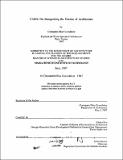CADD : on reorganizing the practice of architecture
Author(s)
Cavoulakos, Constantin Elias
DownloadFull printable version (3.270Mb)
Alternative title
Computer aided design and drafting : on reorganizing the practice of architecture
Other Contributors
Massachusetts Institute of Technology. Dept. of Architecture.
Advisor
Ranko Bon.
Terms of use
Metadata
Show full item recordAbstract
The architectural office of the end of the eighties has been equipped with computers, in an effort to anticipate the needs of the modem working environment and to enhance the informational flow between the various disciplines of modern practice. A basic concern for the architect in the computerized office, is not what is commonly thought, to probe the limits of the machine, or to explore the sophistication of the software in use; rather it is to grasp how the computer affects performance at work, altering the traditional hierarchy of our perception and decision making, in order to strengthen productivity by changing the traditional organization of architectural practice. Development of design software enhances the man-machine interface, encouraging the architect to work directly on the machine, leading towards a true integration of the computer in the practice. While a small computer team, composed by CADD specialists, initially supported the computer facilities in architectural practice, it is particularly important to demonstrate that every professional should be able to access, and work directly on the computer, adding to the dissemination of technical knowledge within the team and of the benefits of the efficiency of the electronic tool. This is beneficial to both the designers of the firm, who are able to minimise redundancy in the creation of graphic documents, and to the CADD support team of the office, that can concentrate in research and development of an increasingly powerful computer-aided design environment. Integrating CADD in architectural practice depends on the organization of the particular office. A crucial question for the architect and the central topic of this thesis is how to put designers at work in front of the screen, and how to control decision making within the CADD environment. My goal is to describe the various issues involved and to suggest a direction in the implementation of CADD in the architectural office. Keywords: CADD, Representations, Horizontal Organization, Vertical Organization, Multi-disciplinarity, Integration, Architectural Practice.
Description
Thesis (M.S.)--Massachusetts Institute of Technology, Dept. of Architecture, 1987. Includes bibliographical references (p. 59-60).
Date issued
1987Department
Massachusetts Institute of Technology. Department of ArchitecturePublisher
Massachusetts Institute of Technology
Keywords
Architecture.